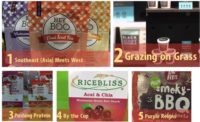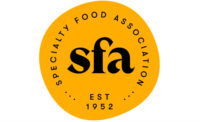Chocolate-filled seaweed wafers, recycled grain snacks, butter toffee worthy of royalty, maple syrup infusions, and a wide diversity of chocolate bars were some of the candy and snack trends spotted at the 42nd annual winter show.
With 80,000 specialty food and beverages from more than 1,400 exhibitors on display, the 2017 Winter Fancy Food Show was the largest to date. Held between January 22 and 24 at Moscone Center in San Francisco, the show provided the opportunity to discover emerging candy and snack product trends. While today’s political environment might seem dicey, the market for specialty foods is very bullish.
“Specialty food sales are exploding right now,” says Phil Kafarakis, president of the Specialty Food Association, which owns and produces the Winter Fancy Food Show. “We’re seeing millennials and men emerging as key consumer groups, foodservice sales are experiencing impressive increases, while online shopping and retail serve as key consumer sales channels. People are very interested in high quality, great tasting food and specialty foods offer both.”
Savory and sweet seaweed snacks for young and old, in a wide variety of flavors, portend a market going mainstream. Land-lover merchandisers who ignore this segment do so at their peril.
Another surprise was butter toffee, or English-style toffee, stretched into several different delicious applications. Such as, Hope & Harmony’s Butter Toffee Peanuts, Bissinger’s Coffee Toffee Dark Chocolate, and Everton Toffee’s Butter Toffee Caramels, a resurrected Victorian era brand.
Turmeric, known for its anti-inflamatory properties, is cropping up in more good-for-you snacks. Examples: Living Intensions’ Tandoori Turmeric Superfood Popcorn and Vegan Rob’s Turmeric Puffs.
New chocolate products exhibited great diversity, both in terms of ingredients and merchandising. At one end of the flavor scale, two chocolate makers, Amano and Dick Taylor, exhibited unflavored, single origin bars utilizing exquisite beans that have only recently become available. At the other end of the flavor scale, Endorphin Food released a bar so infused with pungent herbs, in this case wormwood, that it might be reminiscent of absinthe. Somewhere in between, Chuao tapped its Latin roots to create bars flavored with mango or tasting like churros.
Marshmallows, once a rubbery, sugary plug, are being tricked out into a variety of colors and culinary flavors. Examples: Smash Mallow’s Lemon Chia Seed, Root Beer Float, and Espressso Bean Marshmallows; and Hammand’s Snickerdoodle and Key Lime Mellow Fluffs.
And lastly, the naturally sweet and colorful beet was bountiful, now appearing in ketchup (Foraging Fox’s Beetroot Katchup) and salsa (Natalie’s Gourmet Foods’ The Original Beet Salsa).
The following pages contain descriptions of the nine most noteworthy product from the show.
1. Ocean’s Halo
Robert Mock had been following a traditional career path, but his young children changed all that. When his kids returned home from their new West Coast elementary school, they chattered about the seaweed they had eaten for lunch. “It’s a custom for school kids to trade snacks and, apparently, seaweed was the gold standard for the trade. And my kids quickly adapted to the taste of seaweed,” explained Mock.
He had been a successful derivatives trader for two of the country’s largest banks. But spotting an opportunity, Mock soon exchanged financial derivatives for an ocean’s catch, and in 2013 co-founded New Frontier Foods Inc. and the brand Ocean’s Halo.
His mission is to “create healthy, delicious and innovative new products that break down the barriers for people to try seaweed as a snack or ingredient.” Rather than selling traditional Asian-flavored wasabi or teriyaki seaweed snacks, Ocean’s Halo aspires to appeal to a broader set of U.S. consumers with its more popular, trending and innovative savory snack flavors, such as Maui Onion,Texas BBQ, Chili Lime, Sriracha, and Korean BBQ.
At Fancy Food, the company launched four sweet seaweed snacks that use strips of nori to sandwich a layer of either sliced almonds or coconut flakes and also with a touch of dark chocolate, all products that are sure to trade well at the kids’ elementary school. The company also launched USDA Organic Sushi Nori sheets, Korean BBQ Snacks and Chili Lime Snacks.
Almond, Coconut, Almond & Chocolate, and Coconut & Chocolate strips; 0.88 oz./ 25 g.; $3.99 S.R.P.; Korean BBQ and Chili Lime Snacks; 0.14 oz./4.0 g.; $1.49 S.R.P.
2. ReGrained
What’s really amazing about today’s specialty food industry is how some visionaries can take a waste byproduct and upcycle it into another delicious food. Kind of like the Grimms Brothers’ character, Rumpelstiltskin, who magically transformed cheap straw dross into golden floss.
Three recent examples: Coffee Flour, a company that turns coffee cherry pulp waste (38 million lbs. to date) into a high protein and fiber, gluten-free flour. Barnana, who buys organic overripe, bruised, and otherwise unsaleable bananas from farmers (11.7 million bananas to date) and dehydrates them into a high-energy snack. And New Seasons Market (a 19-store chain) selling trash or bycatch fish to chefs attracted by their sustainability and low cost.
Enter two home brewers who pondered what to do with the spent malt that was cluttering up their kitchen. Apparently, beer brewing is wasteful: it takes approximately one pound of grain to produce a six-pack of beer.
Dan Kurzrock and Jordan Schwartz discovered that grain is also very nutritious, containing protein, fiber, and nutrients. They formed a company, called ReGrained, and took this nutritious byproduct and turned it into something delicious. Or, as its website states, “from farm to foam to food.”
They work with San Francisco brewers to collect the spent grain, which the brewery would normally have to pay someone to haul away. Kurzrock estimates that a small brewpub with a five-barrel system can generate enough spent grain in a single day to make 15,000 bars.
“We’re closing a loop between the brewing industry and food system. By ‘upcycling’ this grain, we have sustainability baked into our model, but we aren’t just selling virtue here; our products also have to taste great, and hit the market at the right price point.”
ReGrained exhibited its two products, Honey Cinnamon IPA Bar and Chocolate Coffee Stout Bar at the show. While initially beer drinkers might be drawn to it because of the ingredients, these bars should appeal to anyone, including children. They don’t contain alcohol or hops; and don’t taste like beer. Each bar contains 6 to 7 grams of sugar, 3 grams of fiber, 140 calories, and 3 grams of protein. The company is experimenting with producing beer flour.
In short, ReGrained makes it possible to have your beer and eat it, too.
ReGrained; Honey Cinnamon IPA Bar and Chocolate Coffee Stout Bar; 1.2 oz./ 33 g.; $2.50 S.R.P.
3. Everton Toffee Co.
Lovers of the new PBS historic drama series, Victoria, should be thrilled to learn that one of the queen’s favorite confections has been resurrected and is now available to the American public. Founded in 1753, the Everton Toffee Co. once produced butter toffees much sought after, not just by Queen Victoria, but by such notables as Charles Dickens. The company has long since closed, and all that remained of its legacy was the local football team, which had honored the company by naming itself the Toffees.
Then, two years ago, Rory Ritts revived the brand, researched the recipe and updated it to conform with current, clean manufacturing practices. The Everton Toffee Co. sells butter toffee caramels and pretzels. “We believe that we’re the only ones in the United States making butter toffee pretzels,” says president Ritts. Products are available in gusseted pouches and tins decorated with 19th century designs. He has offered to supply the London-based Dickens Museum with product and give back some of the sales proceeds.
Everton Toffee; Butter Toffee Prezels and Butter Toffee Caramels; 4.0 oz./ 113 g.; $4.99 S.R.P.
4. Crown Maple
Credit the Tonewood Co., which won a SOFI gold in 2013, for raising consumer awareness in maple syrup. In the intervening three years, the specialty food industry has exploded with innovative products celebrating America’s native sweetener. The syrup is now marketed in spirit bottles, like craft bourbon, and flavored with an increasing palette of infusions. One exhibitor, Runamok Maple, offered nine different infused-flavored maple syrups, including cardamom, elderberry, hibiscus, and makrut lime leaf.
I will profile Crown Maple, a Hudson Valley, N.Y., producer that in 2010 created one of the country’s first estate-produced, craft maple syrups available nationally. The company’s Very Dark syrup was a 2015 SOFI finalist.
CEO Michael Cobb credits the infatuation with maple syrup-based products to the syrup’s versatility, because it “takes on flavors very easily, whether it is sweet or savory; the applications are endless.” One of his customers, Oliver Kita, who received a “Top 10 Chocolatier” award by Dessert Professional Magazine, uses it in his Crown Maple Syrup Pecan Praline Bar.
The company has expanded its offerings with infused syrups (Cinnamon and Madagascar Vanilla), Bourbon Barrel Aged and Applewood Smoked.
Crown Maple Artisan Flavor line, 375 ml, $16.99 S.R.P.
5. Vegan Rob’s
Vegan Rob’s is a relatively new snack company founded by Rob Ehrlich, who years ago created the successful Pirate’s Booty line of extruded and pellet snacks. Since I cited the company in my review of products exhibited at the summer 2016 Natural Products Expo East, Ehrlich has been very busy adding several new good-for-you snack products to his Vegan Rob’s brand.
These include Apple Cider Vinegar Puffs, which contain sorghum that Ehrlich claims is a digestive aid. Also Musk Melon Popcorn that has “many benefits for weight loss and blood flow and is revered in Japan,” he notes. And Jackfruit Puffs. Considered the largest tree-born fruit that can weight up to 100 pounds, jack fruit is gaining traction as a healthy ingredient because it contains dietary fiber, minerals, and vitamins. The company is also exploring ingredients influenced by India’s Ayruveda system of medicine, such as Turmeric Puffs and Ginger Puffs.
Vegan Rob’s; Apple Cider Vinegar Puffs, Musk Melon Popcorn, Jackfruit Puffs, Turmeric Puffs, and Ginger Puffs; 3.5 oz./ 99 g.; $3.99 S.R.P. and 1.25 oz./35 g.; $1.50 S.R.P.
6. Amano Artisan Chocolate
Art Pollard, Amano’s chocolate maker, is possibly America’s most highly awarded craft chocolate maker. His new Macoris 70% dark bar uses beans from a small cooperative in the San Francisco de Macoris region of the Dominican Republic. It took Pollard seven years to persuade a single set of farmers to sell him some beans, as they had enough demand in their local market. It is worth the wait, as he considers these beans to be as exclusive as those from Chuao, Venezuela, a source some people consider the Burgundy of beans. “Both these beans have a richness and lots of layers of flavor and are only available in very limited quantities.” Tasting notes mention that the cocoa has a mild and gentle chocolate flavor; with hints of molasses, brown sugar/muscovado, cream, nuts, and dried apricots. And it’s great for chefs.
Amano Artisan Chocolate; Macoris bar; 3.0 oz./ 85 g.; S.R.P. $8.00.
7. Dick Taylor Craft Chocolate
Dick Taylor displayed its limited release 78% Tien Giang bar, using Vietnamese beans. Good quality Vietnamese beans have only recently become available, thanks to the work of Ho Chi Minh City-based Marou Faiseurs de Chocolat. The beans were grown in the Mekong Delta by Pham Thanh Cong, who this past January received the 13th heirloom cacao designation by the Heirloom Cacao Preservation Project, a partnership with the USDA and the Fine Chocolate Industry Association. Co-owner and Head Chocolate Maker Adam Dick described the chocolate as having a “spice cake, almond butter, holiday spice, dried fruit and nutty finish.”
Dick Taylor Craft Chocolate; 78% Tien Giang bar; 2.0 oz./ 57 g.; $10.00 S.R.P.
8. Endorfin Foods
With regard to chocolate making, Enforfin Foods takes a less traveled road. Most chocolate makers use roasted beans, dairy for their milk bars, and some light flavoring agents like vanilla. In contrast, this San Francisco-based bean-to-barsmith uses unroasted beans, coconut sugar, coconut milk (the company calls it “mylk”), and a liberal use of spices. Its intent, explains the self-described alchemist and founder Brian Wallace, is to “unite the indulgent side with the healthy side of chocolate.” Hence the company’s name, which is a play on endorphin, the endogenous neurotransmitter involved in our ability to experience pleasure and euphoria.
The bar that caught my attention at the show was an absinthe- and anise-flavored bar, packaged with text in green lettering to invoke the bitter absinthe liquor that gave 19th century French poets, painters, and paupers green-tinged hallucinations. Wallace’s interest in botanicals stems from a lifelong study of plant science and a desire to “bring back classical and long-forgotten flavor profiles and ingredient combinations.”
His next project is to install an in-house still to create his own plant-derived essential oils. “By doing this we will be capturing the full range of nuanced flavor in a particular spice or herb, and not just the singular, flat flavor note present in most flavored confections on the market.”
As mentioned above, Endorfin uses coconut sugar, which is both low glycemic and adds a nice caramel flavor note. Some of the bars also use coconut milk that adds a super soft luxurious mouthfeel and melt down. Another point of distinction: in keeping with their farm-to-table ethos, the company offers a Community Supported Agriculture (CSA) model, except it’s a Community Support Chocolate (CSC), with bars distributed on a monthly basis to its subscribers. Wallace plans to bring the companies’ new still direct to farms and into the forests of California, to distill fresh citrus fruit or Douglas fir branches minutes after harvest, and to then use these flavors to craft unique new confections.
Endorfin Foods; Absinthe Dark Coconut Mylk Chocolate with Anise & Wormwood Bar; 1.4 oz/ 40 gr; $5.99.
9. Chuao Chocolatier
Chuao’s founder Michael Antonorsi continues to entrance his fans with new chocolate products embued with his playful and indulgent soul. At the show he launched two bars that celebrate Chuao’s Latin heritage — he hails from Venezuela — while channeling popular Latin street food.
The first new product is Cheeky Cheeky Churro, which can invoke memories of purchasing a freshly made churro from a churrerías during a holiday or at a theme park. It is a Mexican-style churro made with cinnamon and granulated brown sugar and swirled in dark chocolate.
The second product is Totally Tangy Mango, a dark chocolate bar containing mango and sprinkled with tart lime, sea salt, and chile. Antonorsi explains that he is attempting to replicate the snacks sold by Mexican fruit cart vendors, who squirt chamoy on the fruit. A typically Mexican condiment, chamoy provides a salty, sweet and spicy counterbalance to the sweet fruit. Additionally, “it has an accentuated acidity that makes your mouth salivate, and gets you prepped for eating more chocolate. This acidity makes for a whole new taste experience, a really bright and refreshing taste.”
Chuao Chocolatier; Totally Tangy Mango and Cheeky Cheeky Churro; 2.8 oz./ 80 g.; $4.99 S.R.P.














